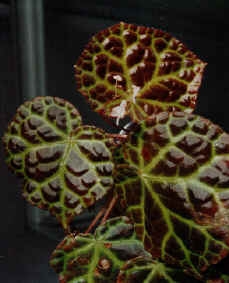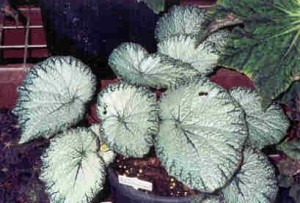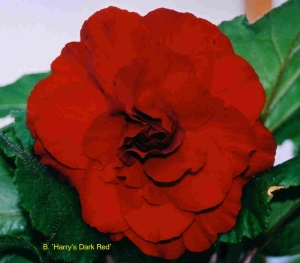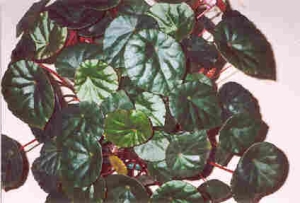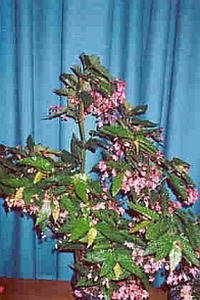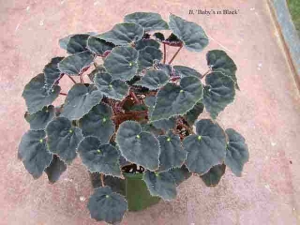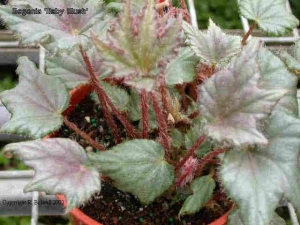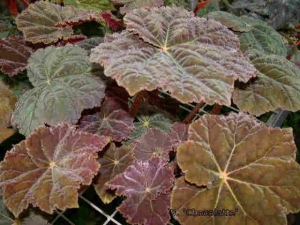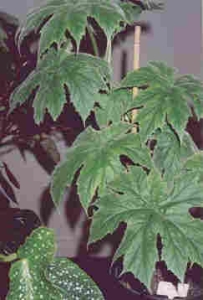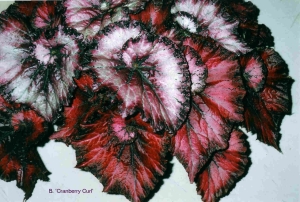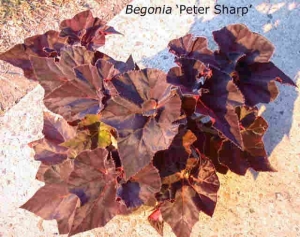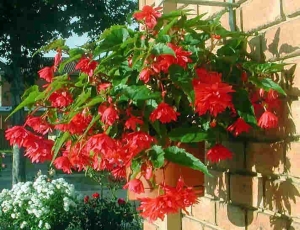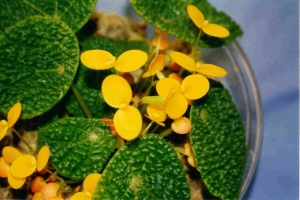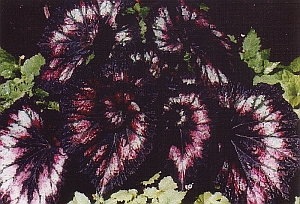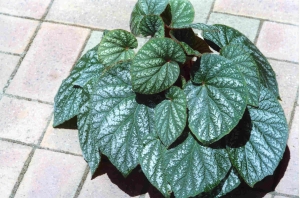B. cinnabarina
Discovered in Bolivia in 1849, This is one of the species tuberous Begonias from which our present day large double flowered tuberhybrida types were developed. It has small orange flowers displayed on tall erect stems.
B. rajah
This is a species Begonia of the rhizomatous type. It was discovered in Malaya in 1894 by Ridley. It is strictly a closed container plant which enjoys high humidity but will not tolerate wet feet. Water only when necessary. It will look its best when grown in a cool position with low light levels. Too much light/heat will cause the leaves to lose their rich colour.
B. ‘Orange Crush’
An upright tuberhybrida Begonia hybridised in Australia by Ralph Willsmore. A beautiful creamy-white ground picotee with lightly ruffled orange-scarlet edge. Flowers prolifically. Tolerates heat quite well.
B. ‘Melisse’
B. ‘Arabelle’ and B. ‘Melisse’ are reported by the hybridiser, Constance Bower as both being from the crossing of B. ‘Margraitacea’ with B. ‘Lulu Bower’ and registered in 1957. The best way to determine which one is B. ‘Melisse’ is to run the leaf over your lower lip! B. ‘Melisse’ is hairless. This Mallet begonia belongs to the Cane like Begonias.
B. ‘Fred Martin’
B. ‘Fred Martin’ was named after the late President of the British National Begonia Society by Blackmore and Langdon.
In his book, ‘Begonias, the Care and Cultivation of Tuberous Varieties’ (1989) Brian Langdon wrote that, in the opinion of many growers, this was the finest picotee yet raised because of its perfection of form and the splendid placement of the broad petals. Today it is still a firm favourite amongst the tuberous Begonias.
B. ‘Orange Dream’
A beautiful tuberhybrida produced by Ralph Willsmore of South Australia. Exquisite, large, rose formed blooms of rich orange are in abundance on this relatively compact plant.
B. ‘Flamingo Queen’
Originator: Ross Bolwell 1990
Parents: B.U078 (maculata) x B. ‘Leonore Oliver’
This hybrid, developed in New South Wales, Australia, has become very popular in the U.S.A. and won the American Begonia Society’s Alfred D Robinson Medal which is made to a Begonia cultivator that has been released for at least five years and not more than fifteen. Cane Like plant with dark green leaves with varying sizes of silver spots and silver spotted margin. Pink flowers.
The plant photographed was winner of the Hazel Burley Memorial Trophy at the Queensland Begonia Society inc. 2003 show. Grown by Barry Mann.
B. ‘Silver Greenheart’ – Rex cultorum.
Originator: Woodriff 1981
Parent: B. grandis ssp evansiana
Silver leaves with deep green vein outlines and edge “stitched”.
B. boliviensis
This is one of the original species from which our modern day tuberhybrida have been developed. Discovered in the South American Andes in the late 1850’s, it has long slender stems with narrow, fuchsia like flowers of vermillion-red.
B. ‘Harry’s Dark Red’
Originator: Ron Cutten
The major feature of this Begonia, developed in Victoria, Australia, is the depth of the red colour, especially in the young flower. Can be almost a red – black. One of the deepest red tuberhybrida available.
B. coriacea
B. coriacea originally came from Java in 1844. This Rhizomatous begonia’s leaves are bronzy-green, shield shaped, with maroon stems. The underneath of the leaf is also maroon. The flowers are pink. Propagation is by seed or cuttings.
This particular plant was grown by Jane and Paul Blundell and features in the Winter 2003 edition of the Queensland Begonia Society Inc’s journal.
B. ‘Margaret Mitchell’
The originator of this delightful cane-like Begonia was John Miller. The green angel wings leaves are covered with white spots. Flowers are pink. Being a hybrid it can only be propagated successfully by cuttings.
This particular plant, grown by Enid Henderson, features in the winter 2003 edition of the journal produced by the Queensland Begonia Society Inc.
These three photographs have come from Ross Bolwell, a well known Australian hybridiser.
B. ludwigii
This thick stemmed Begonia originated in Ecuador in 1937. It has deeply lobed, olive-green leaves. The leaves and stems are covered in fine white hairs. The flowers are pale pink.
This photograph is featured in the Spring 2003 journal of the Queensland Begonia Society Inc.
B. ‘Fireworks’
Parents: B. cathayana x Rex cultivar
Originator: Kartuz, 1976
This rex cultorum has young leaves light mauve to purple, going silver to green as the leaves age. Flowers are pink.
This particular plant was grown by Carmel Browne and is featured in the Spring 2003 edition of the Queensland Begonia Society Inc. journal.
B. ‘Cranberry Curl’
The originators of this delightful Rex begonia are Paul and Jane Blundell from Queensland. Originating in 2002, its parents are both unnamed Rex cultorum. The leaves are basal lobed and spiralled.
This photo is featured in the Autumn 2004 edition of the Queensland Begonia Society Inc. Journal.
These three Begonia hybrids were developed by Ross Bolwell and are named after leading folk within the N.S.W. Begonia Society.
John Clare is a well-known begonia hybridiser from Queensland.
This delightful Begonia was grown by Sharlie Cousland of the Melbourne Begonia Society. Possibly named ‘Tenella Rose’.
B. microsperma = B. ficicola
First discovered in 1895, this species was rediscovered in 1946 in Cameroon on the west coast of central Africa and given the name B. ficicola (fig loving) because it was growing on a Ficus tree. Grows well in a terrarium.
This plant was grown and photographed by Ken and Carmel Browne.
These two tuberhybrida have been hybridised by Ralph Willsmore from South Australia.
B. ‘Becky Jane’
B. ‘Flirtation’
Ralph has now retired from commercial growing of Begonias.
These four begonias all bred by Lyla Kilpatrick in Western Australia.

